当前位置:
X-MOL 学术
›
npj Sci. Learn.
›
论文详情
Our official English website, www.x-mol.net, welcomes your
feedback! (Note: you will need to create a separate account there.)
Genetic associations with mathematics tracking and persistence in secondary school.
npj Science of Learning ( IF 3.6 ) Pub Date : 2020-02-05 , DOI: 10.1038/s41539-020-0060-2 K Paige Harden 1 , Benjamin W Domingue 2 , Daniel W Belsky 3 , Jason D Boardman 4 , Robert Crosnoe 5 , Margherita Malanchini 1 , Michel Nivard 6 , Elliot M Tucker-Drob 1 , Kathleen Mullan Harris 7
npj Science of Learning ( IF 3.6 ) Pub Date : 2020-02-05 , DOI: 10.1038/s41539-020-0060-2 K Paige Harden 1 , Benjamin W Domingue 2 , Daniel W Belsky 3 , Jason D Boardman 4 , Robert Crosnoe 5 , Margherita Malanchini 1 , Michel Nivard 6 , Elliot M Tucker-Drob 1 , Kathleen Mullan Harris 7
Affiliation

|
Maximizing the flow of students through the science, technology, engineering, and math (STEM) pipeline is important to promoting human capital development and reducing economic inequality. A critical juncture in the STEM pipeline is the highly cumulative sequence of secondary school math courses. Students from disadvantaged schools are less likely to complete advanced math courses. Here, we conduct an analysis of how the math pipeline differs across schools using student polygenic scores, which are DNA-based indicators of propensity to succeed in education. We integrated genetic and official school transcript data from over 3000 European-ancestry students from U.S. high schools. We used polygenic scores as a molecular tracer to understand how the flow of students through the high school math pipeline differs in socioeconomically advantaged versus disadvantaged schools. Students with higher education polygenic scores were tracked to more advanced math already at the beginning of high school and persisted in math for more years. Analyses using genetics as a molecular tracer revealed that the dynamics of the math pipeline differed by school advantage. Compared to disadvantaged schools, advantaged schools buffered students with low polygenic scores from dropping out of math. Across all schools, even students with exceptional polygenic scores (top 2%) were unlikely to take the most advanced math classes, suggesting substantial room for improvement in the development of potential STEM talent. These results link new molecular genetic discoveries to a common target of educational-policy reforms.
中文翻译:

遗传与中学数学跟踪和坚持的关联。
最大限度地提高科学、技术、工程和数学 (STEM) 渠道的学生流动对于促进人力资本发展和减少经济不平等非常重要。 STEM 管道中的一个关键时刻是中学数学课程的高度累积序列。来自贫困学校的学生完成高等数学课程的可能性较小。在这里,我们利用学生多基因分数(基于 DNA 的教育成功倾向指标)对不同学校的数学管道有何不同进行了分析。我们整合了 3000 多名来自美国高中的欧洲血统学生的基因和官方学校成绩单数据。我们使用多基因分数作为分子示踪剂来了解社会经济优势学校与弱势学校的高中数学管道学生流动有何不同。具有高等教育多基因分数的学生在高中一开始就被跟踪到更高级的数学,并坚持数学更长时间。使用遗传学作为分子示踪剂的分析表明,数学管道的动态因学校优势而异。与弱势学校相比,优势学校可以缓冲多基因分数较低的学生放弃数学的机会。在所有学校中,即使是具有优异多基因分数(前 2%)的学生也不太可能参加最高级的数学课程,这表明潜在 STEM 人才的发展还有很大的改进空间。这些结果将新的分子遗传学发现与教育政策改革的共同目标联系起来。
更新日期:2020-02-05
中文翻译:

遗传与中学数学跟踪和坚持的关联。
最大限度地提高科学、技术、工程和数学 (STEM) 渠道的学生流动对于促进人力资本发展和减少经济不平等非常重要。 STEM 管道中的一个关键时刻是中学数学课程的高度累积序列。来自贫困学校的学生完成高等数学课程的可能性较小。在这里,我们利用学生多基因分数(基于 DNA 的教育成功倾向指标)对不同学校的数学管道有何不同进行了分析。我们整合了 3000 多名来自美国高中的欧洲血统学生的基因和官方学校成绩单数据。我们使用多基因分数作为分子示踪剂来了解社会经济优势学校与弱势学校的高中数学管道学生流动有何不同。具有高等教育多基因分数的学生在高中一开始就被跟踪到更高级的数学,并坚持数学更长时间。使用遗传学作为分子示踪剂的分析表明,数学管道的动态因学校优势而异。与弱势学校相比,优势学校可以缓冲多基因分数较低的学生放弃数学的机会。在所有学校中,即使是具有优异多基因分数(前 2%)的学生也不太可能参加最高级的数学课程,这表明潜在 STEM 人才的发展还有很大的改进空间。这些结果将新的分子遗传学发现与教育政策改革的共同目标联系起来。











































 京公网安备 11010802027423号
京公网安备 11010802027423号